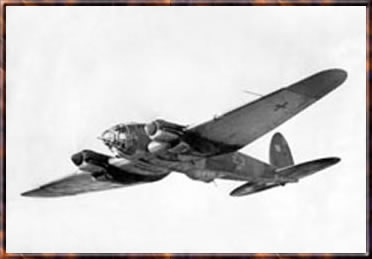
|
|
|
|
|
|
|
|
|
|
|
|
|
|
|
|
|
|
The Heinkel He-111 medium bomber
|
|

A Romanian Heinkel He-111H3 bomber on route towards Tiraspol. June 1941
|
|
||||
 |
In early 1942 , 15 more Heinkel He-111's were ordered from Germany. This time it was Heinkel He-111H6 version, which instead of bombs could carry two 533 mm torpedoes ( one underneath each wing ), but the ARR never used them as torpedo bombers. All available He-111's took part in the Stalingrad campaign, where they took heavy losses. At the start of 1943, all surviving He-111's and their crews were sent back home for R&R.The last order for He-111's was placed in
the summer of 1944, when ten He-111E3 transport aircraft were bought.
|
|||
|
|
Technical data for the Heinkel He-111H3
|
Wingspan
|
22.6 meters
|
|
Length
|
16.4 meters
|
|
Height
|
4 meters
|
|
Weight (empty)
|
8680 kg
|
|
Weight (loaded)
|
14000 kg
|
|
Maximum speed at 6000 meters
|
406 km/h
|
|
Maximum operational ceiling
|
8500 m
|
|
Range
|
1930 km
|
|
Engine
|
Two Junkers Jumo 211D-1 rated at 1200HP
|
|
Armament
|
Six 7.92 mm MG17 machine guns plus one 20 mm MG/FF canon
|
|
Payload
|
Up to 2000 kg
|
|
Crew
|
5
|
|
Numbers received
|
32
|
Technical data for the Heinkel He-111H6
|
Wingspan
|
22.6 meters
|
|
Length
|
16.4 meters
|
|
Height
|
4 meters
|
|
Weight (empty)
|
8680 kg
|
|
Weight (loaded)
|
14000 kg
|
|
Maximum speed at 6000 meters
|
406 km/h
|
|
Maximum operational ceiling
|
8500 m
|
|
Range
|
1930 km
|
|
Engine
|
Two Junkers Jumo 211F-1 rated at 1350HP
|
|
Armament
|
Six 7.92 mm MG17 machine guns plus one 20 mm MG/FF canon
|
|
Payload
|
Up to 2000 kg
|
|
Crew
|
5
|
|
Numbers received
|
15
|